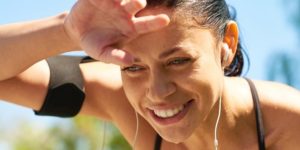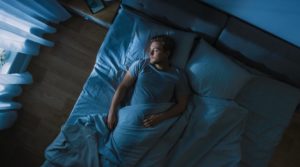
Oesteoporis and osteopenia are often considered to be diseases of post-menopausal women. Sufferers of these diseases that don’t fall into that category are often assumed to be exceptions to the rule. However, bone density is an issue which affects both men and women. Did you know that 1 in 3 men over 60 years will have an osteoporotic fracture in Australia, as will 1 in 2 women? [1]
There are countless studies evidencing that regular physical activity on a long term basis has an important role in maintaining bone health, but when it comes to maintaining bone health, all exercise is not created equal.
Running vs Cycling as a Bone Builder
In 2007, a study from the University of Missouri-Columbia[2] found that men participating in predominantly low-impact forms of exercise have an increased incidence of oesteopenia, resulting in two times the risk of bone fracture.
The study measured bone mineral density in forty three competitive male cyclists and runners ages 20 to 59. The study found that:
- The cyclists had significantly lower bone mineral density of the whole body, especially of the lumbar spine, compared to runners.
- 63 percent of the cyclists had osteopenia of the spine or hip compared with 19 percent of the runners.
- Cyclists were seven-times more likely to have osteopenia of the spine than the runners.
Quite staggering results considering the subjects of the study were competitive cyclists and runners aged under 60. Even the runners had a relatively high incidence of oesteopenia of the hip and spine!
Some Bone Density Facts.
- Studies in pre- and post-menopausal women show that bone mineral density will increase 2 percent to 3 percent after six months of resistance training three times per week. These small changes are quite significant, as a 1% increase in bone density reduces the risk of fracture by 5%. [3]
- Low bone density in males often remains undiagnosed and inadequately treated and, after suffering a fracture, men are less likely to receive follow-up care than women.
- Bone loss in women is approximately 1% – 5% per year after menopause
- When they occur in men, fractures due to oestoeporis or oesteopenia are associated with higher disability and death, than in women.
- Every 5-6 minutes, someone is admitted to an Australian hospital with an osteoporotic fracture. This is expected to rise to every 3 – 4 minutes by the year 2021, as the population ages and the number of osteoporotic fractures increase.
- About 50% of people with one fracture due to osteoporosis will have another. The risk of future fractures rises with each new fracture. This is known as the ‘cascade effect’.
- People who have had two or more osteoporotic fractures are up to 9 times more likely to have another fracture The risk increases to 11 times for people who have had 3 or more fractures compared to someone who has not had one.
- Two thirds of fractures of the spine are not identified or treated.
Risk Factors for Oestoporis
- Family history of osteoporosis and fractures
- Women are at a greater risk of developing osteoporosis than men, mainly due to the rapid decline in oestrogen levels after menopause.
- Men also lose bone as they age, but their bone mass generally remains adequate until much later in life
- Use of cortico-steroids (commonly used for Asthma)
- Rheumatoid arthritis
- Over-active thyroid or parathyroid glands
- Coeliac disease and other chronic gut conditions – which effect the absorpotion of important nutrients such as calcium
- Chronic liver or kidney disease
- Smoking
- Excessive alcohol consumption
- Diet lacking in calcium
- Lack of sunlight exposure, which may cause vitamin D deficiency
- Sedentary lifestyle over many years
In Men
- Symptoms of low testosterone levels such as impotence and lack of libido
In Women
- If your period has stopped for 6-12 consecutive months (excluding pregnancy, menopause or hysterectomy)
- If you experience early menopause
- Consumption of more than 4 cola drinks per week in women (cola drink consumption does not seem to have an impact on bone density in men).
What can you do to reduce the risk of oesteoporisis?
- Choose your parents wisely
- Include weight bearing exercise such as running, resistance training, stair climbing, skipping, hopping, as a regular part of your life.
- Be aware that any positive gains in bone strength are lost when you stop exercising, so that it is important that your exercise is regular and ongoing.
- Ensure you receive adequate amounts of sunshine to boost your vitamin D levels. “To get enough sunlight to produce vitamin D, a person needs to expose their hands, face and arms (around 15% of body surface) to sunlight for about 6 – 8 minutes, 4 – 6 times per week (before 10am or after 2pm Standard Time in summer, for moderately fair people).” [4]
- Ensure your diet includes an adequate intake of calcium, as calcium is vital to maintain bone strength.
Your daily calcium needs depend on your age and sex.
| Children | 1-3 yrs | 500mg/day |
| 4-8 yrs | 700mg/day | |
| Girls | 9-11 yrs | 1000mg/day |
| 12-13 yrs | 1300mg/day | |
| 14-18 yrs | 1300mg/day | |
| Women | 19-50 | 1000mg/day |
| 51+ | 1300mg/day | |
| Pregnancy | 14-18 | 1300mg/day |
| 19-50 | 1000mg/day | |
| Boys | 9-11 yrs | 1000mg/day |
| 12-13 yrs | 1300mg/day | |
| 14-18 yrs | 1300mg/day | |
| Men | 19-70 | 1000mg/day |
| 71+ | 1300mg/day |
Be aware that dairy is not the only good source of calcium. Tahini, nuts and salmon (with bones) are also great sources. See our Calcium Rich Foods table for some more ideas.
[1]Oesteoporosis Australia. http://www.osteoporosis.org.au/about/about-osteoporosis/what-is-osteoporosis/
[3] Ibid;
[4] Oestoporosis Australia http://www.osteoporosis.org.au/about/about-osteoporosis/preventing-osteoporosis-vitamin-d/



